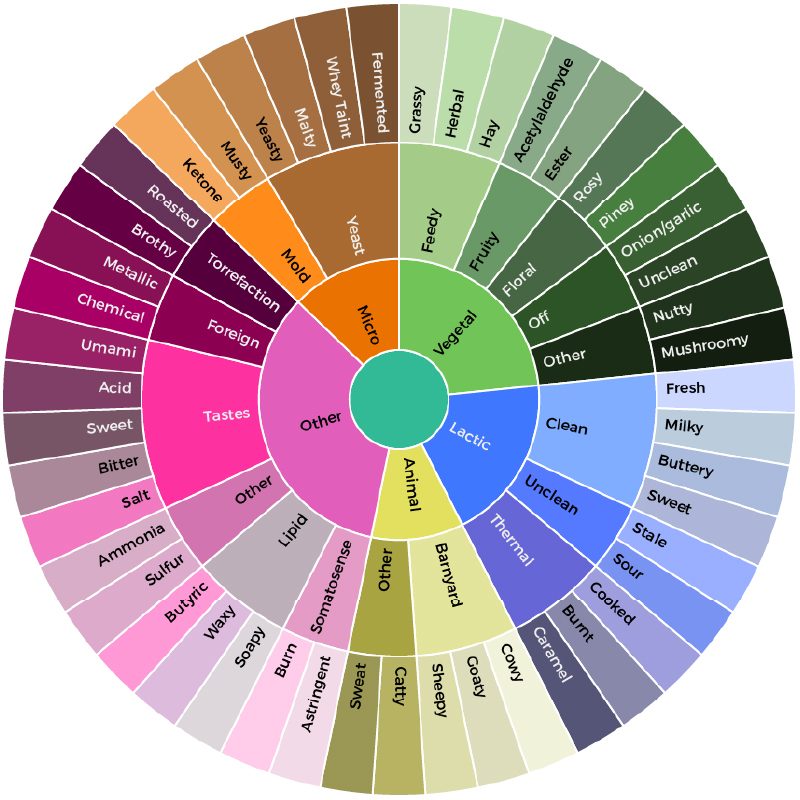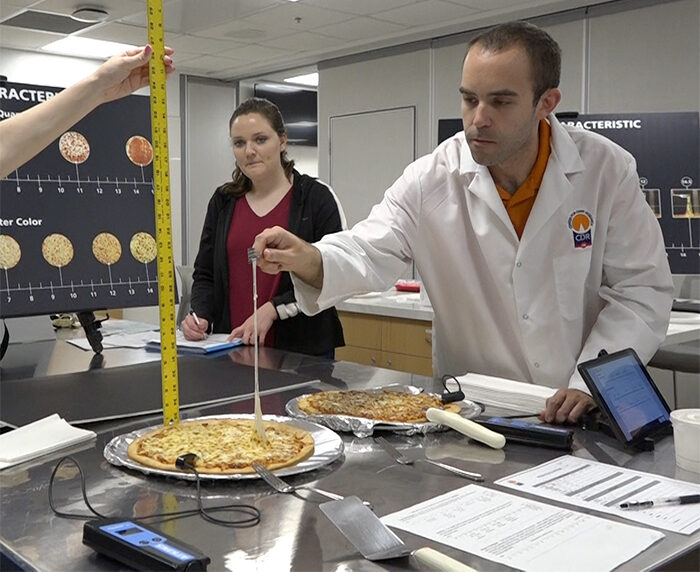Sensory for Quality Assurance
Sensory analysis is a key component of any well-rounded quality assurance program. Most companies don’t have the luxury of hiring and maintaining a standing panel of trained tasters. Instead, the more common method is to have staff participate in quality control sensory panels in addition to their normal work activities.
The most straightforward way to introduce sensory quality control to new
employees is to show differences between a “gold standard” product and a
defective product, and measure an overall difference. Beyond that,
quantifying specific product attributes is often very useful as well.
This method can yield good results when set up correctly. A few key factors to keep in mind are outlines below.
| Guidelines for Quality Control Sensory Panels |
|
Cheese Flavor and Texture Training
Often the first step in cheese sensory training is becoming familiar with the basic flavors and textures that can be found in cheese. It is important to have both a clear definition of what each flavor/texture means, as well as be able to identify them in cheese. The easiest way to accomplish this is to taste cheeses that have a particular flavor in high amounts. Sometimes this isn’t possible, especially for some hard-to-find flavor defects. The same can be said for the different types of textures that can be found in cheese.
Below are some of the most common flavor and texture descriptors for cheese. Each term has a definition and “example cheese”. These cheeses usually have that flavor/texture in high amounts, therefore making it easier to learn each term. Cheeses vary, of course, but this should give you a good starting point. Our Cheese Grading Short Course covers these in much more detail.
| ATTRIBUTE | DEFINITION | EXAMPLES |
| Taste/Flavor/Aroma | ||
| Salt | Basic taste sensation elicited by salt | Mizithra or Pecorino Romano |
| No Salt | Lacking in salt | Paneer |
| Sour | Aroma associated with citric, acetic acids | Fresh goat cheese |
| Acid | Basic taste sensation elicited by acids | Quark or Cream cheese |
| Bitter | Basic taste sensation elicited by bitter compounds | Aged Cheddar |
| Cooked | Aromas and flavors associated with heated milk. Includes sulfurous, sweet and browned notes. | Mascarpone |
| Milky | Aromatics and flavor commonly associated with milk or fresh cream. | Whole Milk Ricotta |
| Buttery | Aromatics commonly associated with natural, fresh butter | Juustoleipa heated up |
| Grassy | Aromatics associated with grass | Irish grass-fed cheddar |
| Fruity | Aromatics associated with different fruits | Parmigiano Reggiano |
| Nutty | Nut-like aromatic associated with different nuts | Emmentaler (imported) |
| Mushroom | Aroma associated with raw mushrooms, damp hummus | Brie (stabilized) |
| Sulfur | Aromatics associated with sulfurous compounds | Vermont Sharp Cheddar |
| Sheepy | Aroma and flavors associated with sheep | Manchego |
| Goaty | Aromatics associated with C6-C10 fatty acids | Fresh chevre |
| Barny/Cowy | Aroma associated with barns and barn animals, indicative of animal sweat and waste | Blue cheese (Tilston Point) |
| Musty | Aromatics associated with closed air spaces | Cave-aged cheddar |
| Butyric/Rancid | Aroma and flavors associated with butyric acid, cheesy, baby-breath/vomit | Sharp Provolone |
| Soapy | Aromatics associated with long chain fatty acids, saponification | Romano (domestic, cow's milk) |
| Ammoniated | Aroma associated with ammonia | Overripe Camembert |
| Ketone/Medicinal | Aroma associated with blue-veined cheeses | Danish Blue or Roquefort |
| Texture/Body | ||
| Short | Breaks easily, easily fractured when manipulated | Aged Cheddar |
| Long | Flexible, does not break easily when manipulated | String cheese |
| Weak | Soft, easily deformed | Overripe Muenster |
| Pasty | Sticky, adheres to hands/mouth | Old Queso Fresco |
| Crumbly | Breaks into large pieces | Young Quesco Fresco |
| Curdy | Breaks into curd particles | Young Colby |
| Mealy | Breaks into cornmeal-size pieces | Juustoleipa |
| Grainy | Breaks into sand-sized pieces | Parmigiano Reggiano |
| Chalky | Leaves a dry chalk-like residue in mouth | Goat milk Feta |
Flavor Wheel
A flavor wheel is a tool to organize attributes in a visually appealing way. The wheel can serve as a thought-starter when trying to characterize.

For more information, please contact the Sensory Coordinator Brandon Prochaska.


